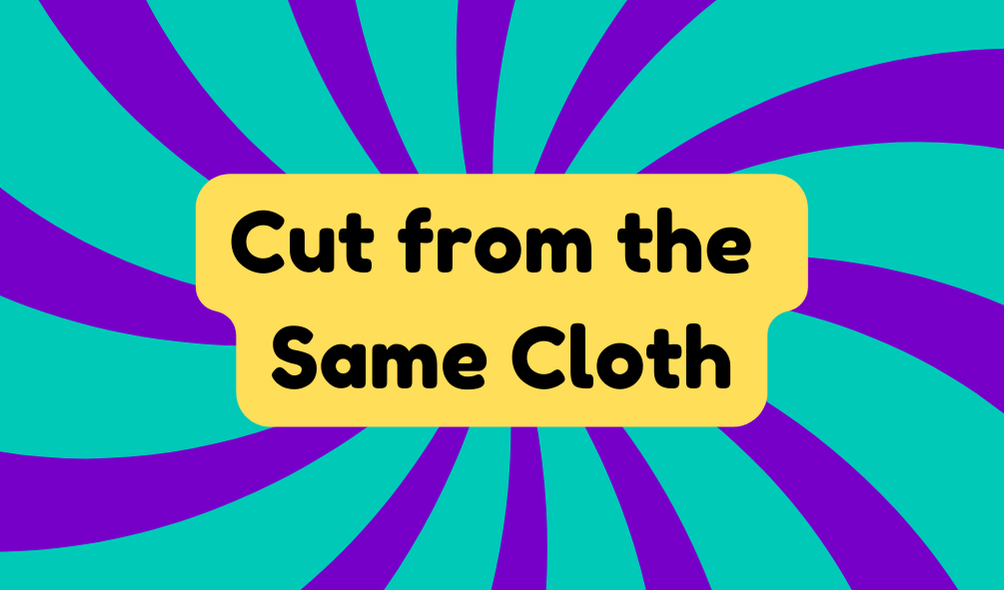When you say someone is "cut from the same cloth," you mean they share similar values, goals, or experiences with you. This phrase originated in the 15th century, referring to fabrics made from the same material. It's used to highlight connections and compatibility among people, suggesting that shared backgrounds can shape who we are. However, relying solely on commonalities can limit creativity and diverse thinking in collaborations. While having similar traits can enhance teamwork, it's also crucial to embrace different perspectives for true progress. You'll find that understanding these nuances opens up new insights into your relationships and collaborations.
Synonyms
When you think of the phrase "cut from the same cloth," several synonyms might come to mind that capture its essence. These alternatives reflect the notion of people sharing similar traits and coming from shared backgrounds.
Here are three fitting options:
- Of like mind: This emphasizes agreement on ideas or values.
- Kindred spirits: This suggests a deep connection through shared experiences.
- Two peas in a pod: This portrays a close relationship based on commonalities.
However, it's vital to remember that while these phrases help convey similarity, they can sometimes oversimplify complex relationships or differences. Acknowledging individual uniqueness, even amidst shared qualities, can lead to more innovative collaborations and meaningful connections, allowing each person's strengths to shine through.
Example of Sentences
The phrase "cut from the same cloth" captures the essence of shared qualities perfectly, illustrating how individuals or groups can exhibit aligned values and attributes. Consider these examples:
- Innovators often form partnerships that echo their shared experiences and drive for change.
- A team thrives when members establish personal connections rooted in common goals.
- Leadership aligns best when executives demonstrate shared beliefs and commitment to growth.
It's important to recognize that while similarities can foster harmony, they can also limit creativity. When you only seek out those who mirror your views, you might miss out on diverse perspectives. It's vital to balance shared qualities with fresh ideas to fuel innovation. After all, real progress often emerges from blending different strengths and experiences.
Origin
Understanding the phrase "cut from the same cloth" requires a look at its origins, which trace back to the mid-15th century. Initially, this phrase referred to the practice of cutting garments from the same piece of fabric, suggesting shared qualities among individuals. As clothing production advanced, it shifted from a literal to a metaphorical meaning, reflecting deeper cultural implications. Historically, this phrase emerged within contexts highlighting connections and compatibility. It emphasizes how shared backgrounds shape people's abilities and values. However, while appealing, one must be cautious about overgeneralizing. In our innovative world, not everyone cut from the same cloth will thrive in the same environment. Recognizing individual uniqueness is essential, even within seemingly similar groups, enhancing overall understanding.
Collocations
While exploring the phrase "cut from the same cloth," you'll find several collocations that enhance its meaning and context. These combinations can shape your understanding of relationships, particularly in professional settings. Consider these examples:
- Shared aspirations—highlighting common goals that drive innovation.
- Compatible partnerships—focusing on the importance of synergy in collaborations.
- Aligned values—emphasizing how mutual principles can foster stronger connections.
However, beware; not every perceived compatibility leads to success. Just because two partners may seem compatible doesn't guarantee effective outcomes. In today's dynamic environment, genuine shared aspirations and proven compatible partnerships are essential for truly impactful collaborations. So, think critically about these connections, analyzing whether they genuinely reflect the essence of being "cut from the same cloth."
How to Use in Everyday Language
When discussing collaborations, it's important to know how to use the phrase "cut from the same cloth" in everyday language. This expression can highlight shared qualities among team members or partners. For instance, you might say, "Our new partners are cut from the same cloth, sharing innovative ideas and ambitious goals." In everyday applications, consider using it in situations where you observe common values or attributes. For example, "Even though they disagree on style, those assistant managers are cut from the same cloth when it comes to hard work." Using this phrase effectively requires context; confirm it aligns with the traits or ideals you're emphasizing. So, think critically about whom you're comparing and why—it matters.
Why Is It Still Relevant Today?
Despite the rapid changes in society and communication, the phrase "cut from the same cloth" remains relevant because it succinctly captures the essence of shared values and qualities among individuals. Today's world thrives on cultural connections and modern collaborations, highlighting how essential it is to foster those bonds. You might think innovation is solely about new ideas, but collaboration often roots itself in shared qualities. When teams realize they're cut from the same cloth, they can break barriers and drive forward progress. Ignoring this connection can stifle creativity and hinder success. So, even in a fast-paced environment, understanding the depth of shared qualities lays the groundwork for meaningful relationships and groundbreaking achievements. It's a concept worth embracing.







